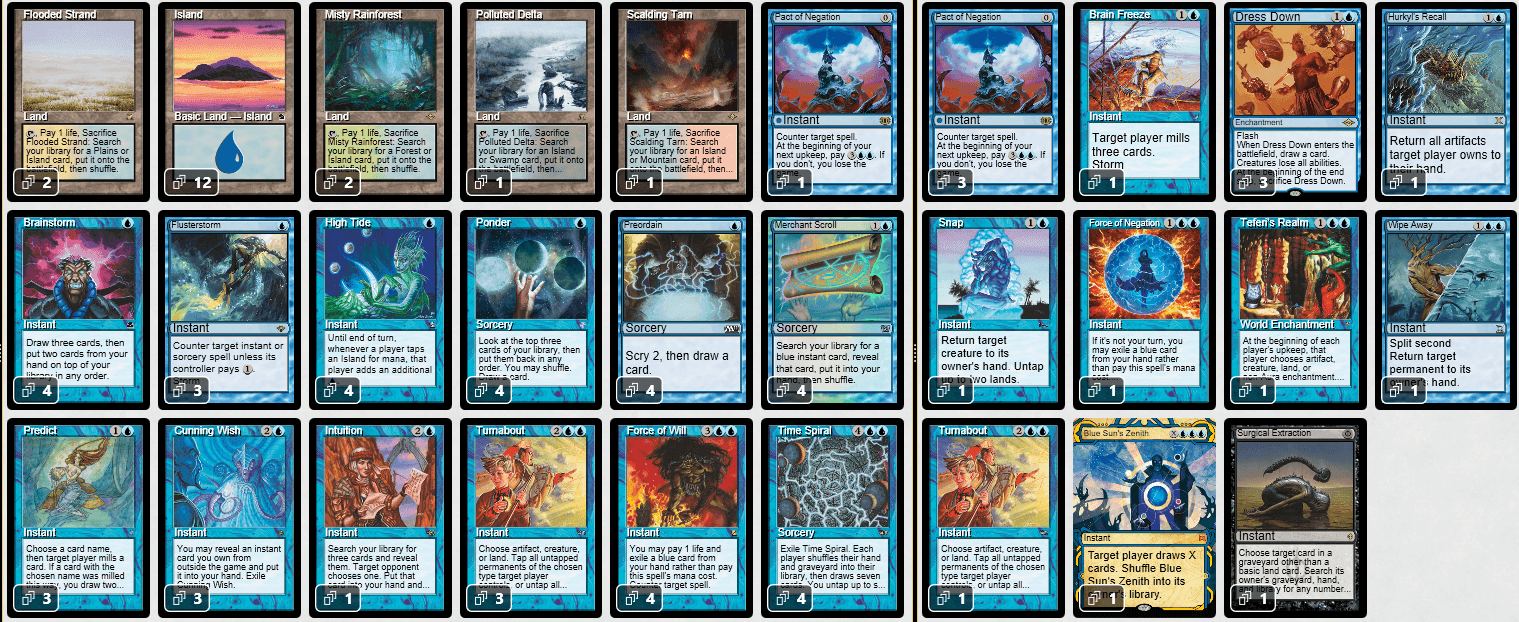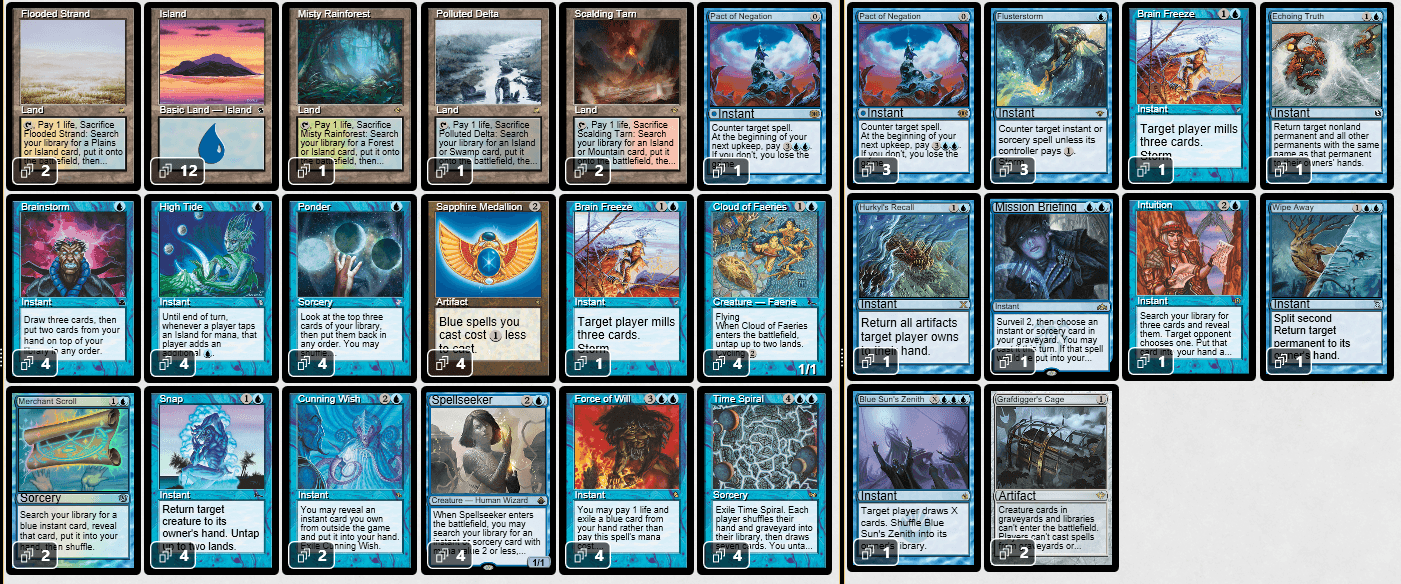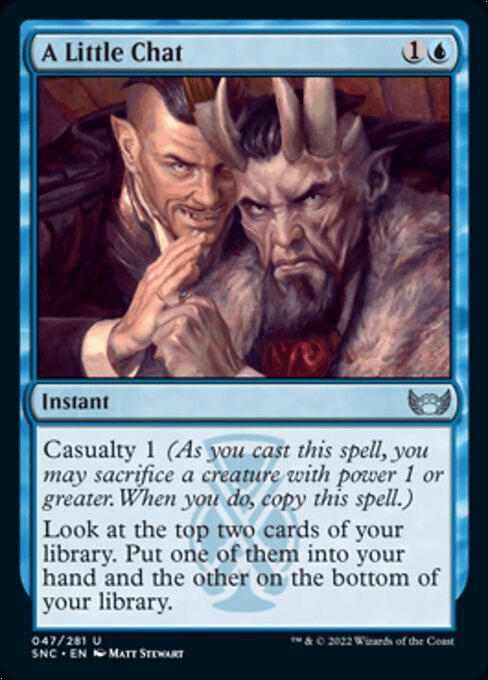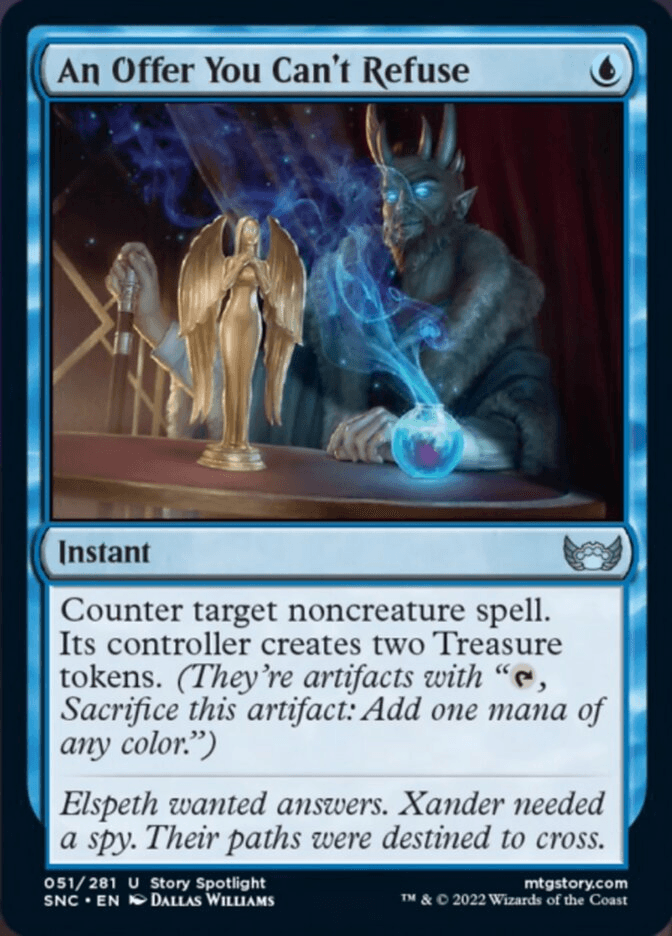Introduction
My name is Marcus and I play on MTGO as “Iwouldliketorespond”. I like blue mana and my favorite format is Legacy.
In a metagame where “innovation” circles around the number of players should run maindeck to combat the “next wave of bannings” I wasn't very optimistic of breaking Legacy with my mono blue pet deck. High Tide is not even innovative or new to begin with. In fact it's quite the opposite dating back to at least 1999 when Kai Budde won a Grand Prix with it.
One day during my daily routine of casting into I was approached by fellow High Tide Enthusiast Felipe Parada (LeMasters on MTGO). Felipe told me that he's been working on “Sapphire Storm”. After me complaining about handing out treasures instead of drawing cards, Felipe explained to me that the deck can win through a by generating enough mana and storm for a kill without even drawing any cards!
What is High Tide?
Traditionally “High Tide combo” is a mono blue combo deck that is looking to resolve the namesake card and pair it together with various untap effects to generate a bunch of mana. This mana is then used to draw more cards….cards that draw even more cards or generate even more mana. Until your opponent ends up with no library (via or ). More often than not they scoop 'em up after you draw 40 (giggling).
The most common version is “SpiralTide” which, you guessed it, combines the card and .

The “Sapphire Storm” version still has access to the classic and powerful - two-card turn 4 combo. Slow and steady. But it also has access to several deterministic turn 3 kills on the back of the many accelerants (, , ) in combination with and . It even has some number of turn 2 kills if you are creative or lucky enough to draw multiple s!

What I really like about this version is how little we “give up” to make space for what is essentially 12 accelerators instead of 3. The added versatility from the “Sapphire Storm package” (consisting of ///) is huge and minimizes the classic combo issue of “too much mana and not enough business” by serving double duty (or more!).
Felipe explains it very well; “Almost all the cards can go forward (for the combo), go back (seekering counterspells, protection, block) or go to the sides (working as cantrips).”
Comparing the lists card for card, Sapphire Storm gives up on some protection () and moves it to the sideboard instead. is “replaced” (I mean nothing really can…) by as the 2-drop of choice. becomes (which in this version is the same mana boost, more on that later). is missed and could very well replace the we include in this version if we want to dial down on the accelerants for more consistency.
We cut 2 and move the Intuition to the sideboard for the s. The third becomes a main deck to have more combo lines available. That's pretty much it. As you can see over half of the changes are basically the same effect on a new card and the other half is trading robustness for speed. However, the “floor” of the added accelerants are pretty high and can turn into business in many ways (for instance by cycling a or aim a at a to go and grab a spell).
No version is “strictly” better but the differences create some interesting space to explore. Most notably in preparation for the upcoming unban (ONE CAN ONLY HOPE). Although I guess the version (Solidarity) is the better shell for that.
Why these cards?
/ can preserve our life total by chump blocking.
/ can pressure planeswalkers or, given enough time, kill the opponent.
is a disruption spell (sometimes a hard answer, i.e targeting Marit Lage, , Germ (but please do wash your hands still)) or an answer to hatebears (with some limitation regarding those with flash, i.e and ) and a combo piece (mana) all at once!
can cycle in a pinch.
Why not these cards?
can be targeted by Artifact Removal
/ can be killed by almost any removal spell. A devastating example is in response to us casting .
/ adds some vulnerability to and ETB-denying cards like .
makes effects similar to stronger (in addition to and fetchlands).
It is a lot harder to generate huge amounts of mana with this deck than with a / based list. Making the kills a little harder.
Deckbuilding also has some additional limitations. The type of anti-permanent hate the deck can run is reduced. One of the best cards printed in the last 10 years, , is not ideal in this deck. Another example of a great sideboard card that becomes worse (but is still very much playable) is .
Comboing Off!

This is a common baseline but often not enough on its own. It's still 42 cards milled with a total of 3 mana to spare somewhere along the line.
One copy of is included in this baseline just to add additional storm and is removed in the other examples below.
It's worth keeping in mind that if you and your opponent both exchange s that's another 6 cards getting milled at the end of the chain. For every cantrip cast another 3 cards and so on.
An alternative to this baseline with almost identical outcome is to replace the in play with a second copy of in hand. In order for this to work you'll need a 4th Island in play or an untap effect in hand ( with a target or ) to ensure that the second copy of is cast before you cast , otherwise the math won't check out when you untap your Islands..
If you are certain that the graveyard is uncontested you can take a detour with to add some additional storm with the floating mana and cast for the fifth time.

This is the money line. With 51 cards milled + 7 cards kept at the beginning of the game + 2-3 cards drawn by turn 3 = enough to empty a 60 card library!
If we are scared of removal on our or if milling 51 cards is not enough (I.E you are up against the mighty who Shuffles or some Dnt player who, instead of shaving 60 added 2, with access to 2 more mana we can go;

is an extremely powerful card and if we choose to go for it there are often tutors to spare for additional copies of or protection.
Sideboard Plans
Felipe was kind enough to provide a Sideboard mapping for some of the common decks.
Vs Delver
-1 -4
+2 +3
Vs Death and Taxes
-1 -1
+1 +1 /
Vs U/X Control
-1 -4
+3 +2
Vs Reanimator
-1 -1 -4
+1 +2 +3
Vs Elves
-1 -1 +2
Looking towards the Future of the Deck
Streets of New Capenna has some additional tools:

Potentially replacing , card has a high upside of potentially “drawing” two cards in combination with any of the creatures in the deck. Being an instant adds some more flexibility as well. Removing might be the wrong cut as this won't help us keep 1-landers the same way does.

An might be very good in this deck. The “inverted ” does not suffer from our boosting our opponent's available mana and unlike we can use it to counter Planeswalkers, Enchantments and Artifacts.
There are many more or less durdly cards that the deck can run. I've tried many but not all of them. If you are looking for a budget option (by shaving ) there are alternate routes with / self mill shenanigans or with the / INF combo, just to name a few. If you have the opposite issue and want to use all of your collection there's probably a version out there. Just mash the two sample lists together and add a playset of s and you are good to go (with 24 lands).
If you are an evil Chalice-person on detox you can still play your Karns in this deck by replacing the es. It's surprising how similar cards you can add for a Karnboard (Hope of Girapuhr, , Walking Ballista, Ratchet Bomb etc). Karn is also amazing with “An Offer you can't Refuse” as the treasures can't be sacced for mana.
You could probably play ///…and .
Thanks for reading and happy s!
